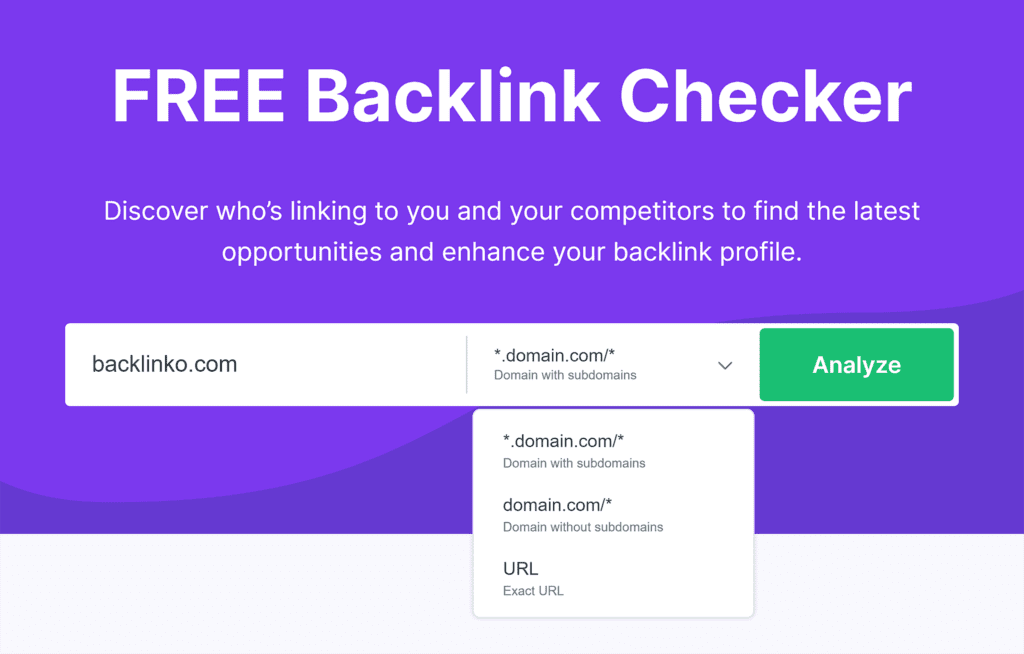16 Easy (And Free) Ways to Promote Your Website
Marketing researcher and educator at Ahrefs. Mateusz has over 10 years of experience in marketing gained in agencies, SaaS and hardware businesses. When not writing, he’s composing music or enjoying long walks.
Article Performance
Data from Ahrefs
Organic traffic
Linking websites
Get SEO metrics of any website or URL.
The number of websites linking to this post.
This post’s estimated monthly organic search traffic.
Get the week’s best marketing content
Free and effective promotion tactics? Yeah, right.
Let me tell you that not only do these marketing tactics exist, but they’re also actually some of the most effective ones. We’ve been using them, other marketers use them, and most of the big websites I’ve seen to date use them.
But that’s not all. You don’t need a degree in marketing or to be a marketing pro to start promoting your website for free and get results. Here are 16 ideas that are free, easy, and effective at the same time.
1. Prioritize easy keywords for SEO
If you’re unfamiliar with SEO, it stands for search engine optimization, and it allows you to get free traffic from search engines like Google.

One of the fundaments of the SEO process is to choose the right keywords to create content for. Now, a tried and tested tactic for new websites and websites without a strong backlink profile is to choose keywords with low ranking difficulty.
You can spot those keywords by mainly looking at two things:
- How many backlinks from unique domains do the top-ranking pages have?
- Do the top-ranking pages belong to a domain with high topical authority?
Here’s how you can do it using Ahrefs’ Keywords Explorer. You can:
- Enter a seed keyword (or multiple seed keywords).
- Go to the Matching terms report and filter the KD (Keyword Difficulty) metric to show keywords with up to 20 KD. This will show you easy keywords based on backlink profile.
- Pick a relevant keyword and open the SERP panel to see what kinds of pages rank. If you see popular brands dominating, those keywords may be hard to rank despite the low KD. SERPs without brands like that should be easier to target.
- Repeat step #3 for every relevant keyword on the list.
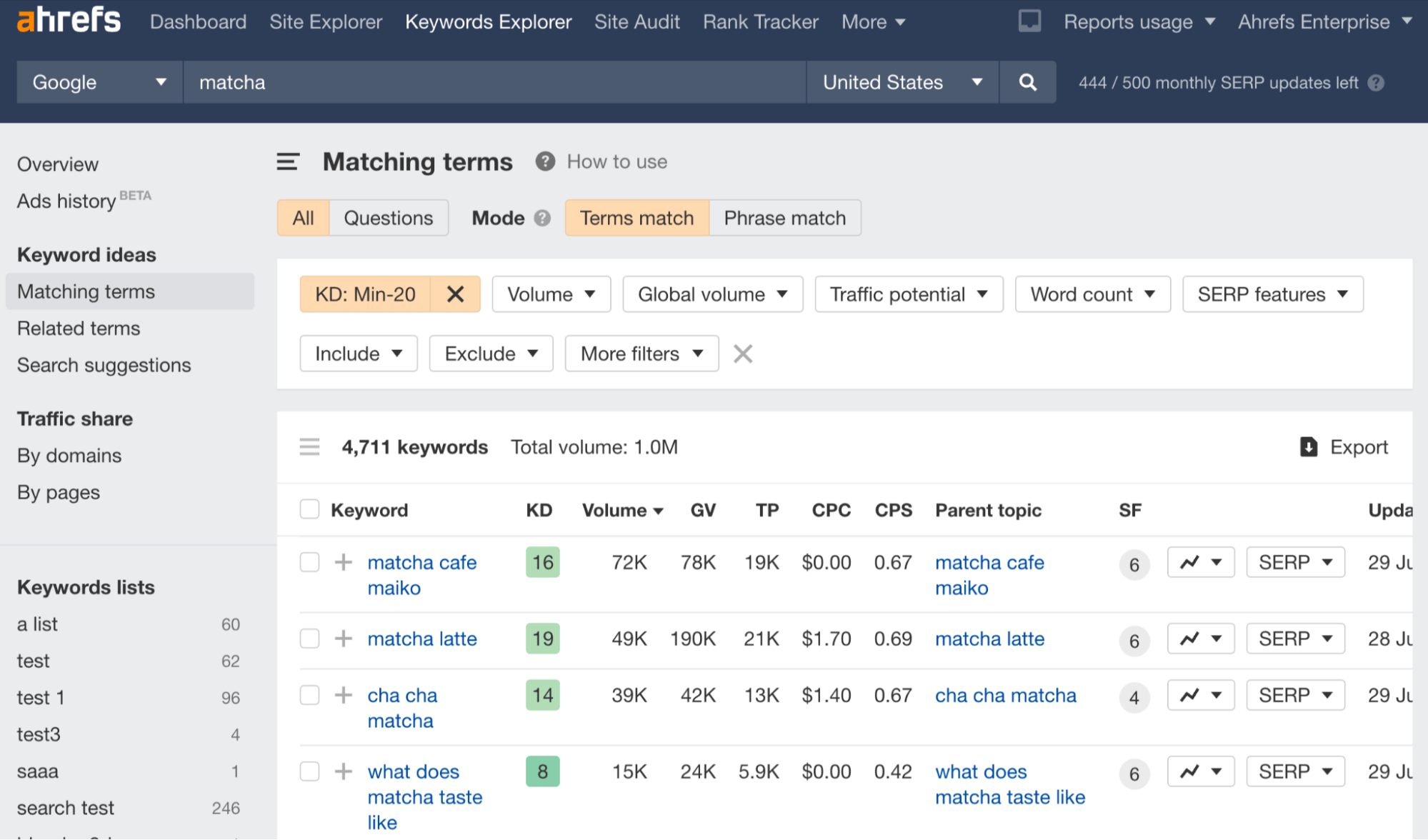
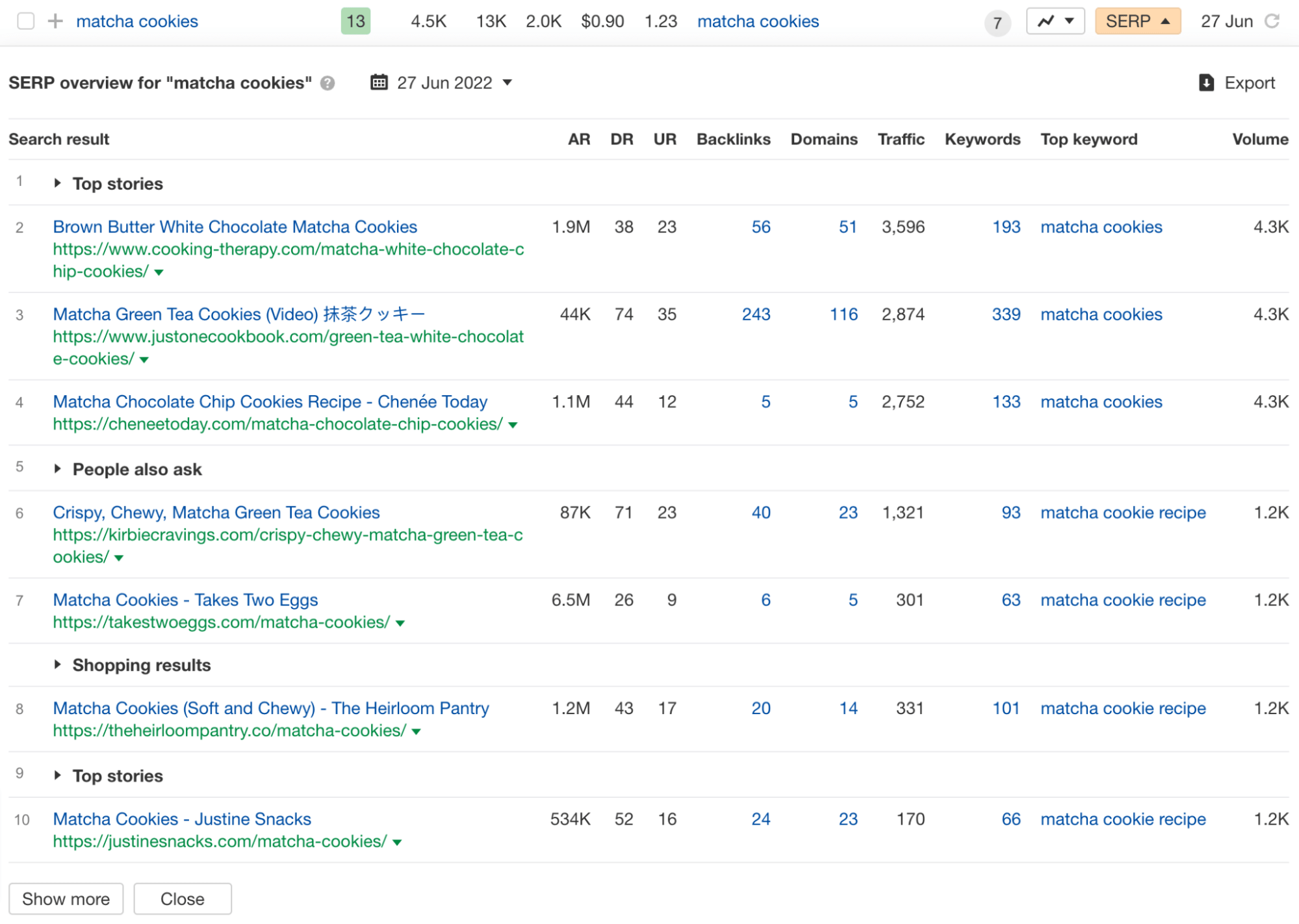
Single low-competition keywords may not offer as much traffic potential. But if you pile up a number of pages targeting these keywords, you can end up with serious organic search traffic.
Also, low-competition keywords may convert better than their more generic counterparts if they are specific enough. One of the neat tricks to find keywords that can possibly convert to sales is to check the CPC ad cost to see if people bid for those keywords.
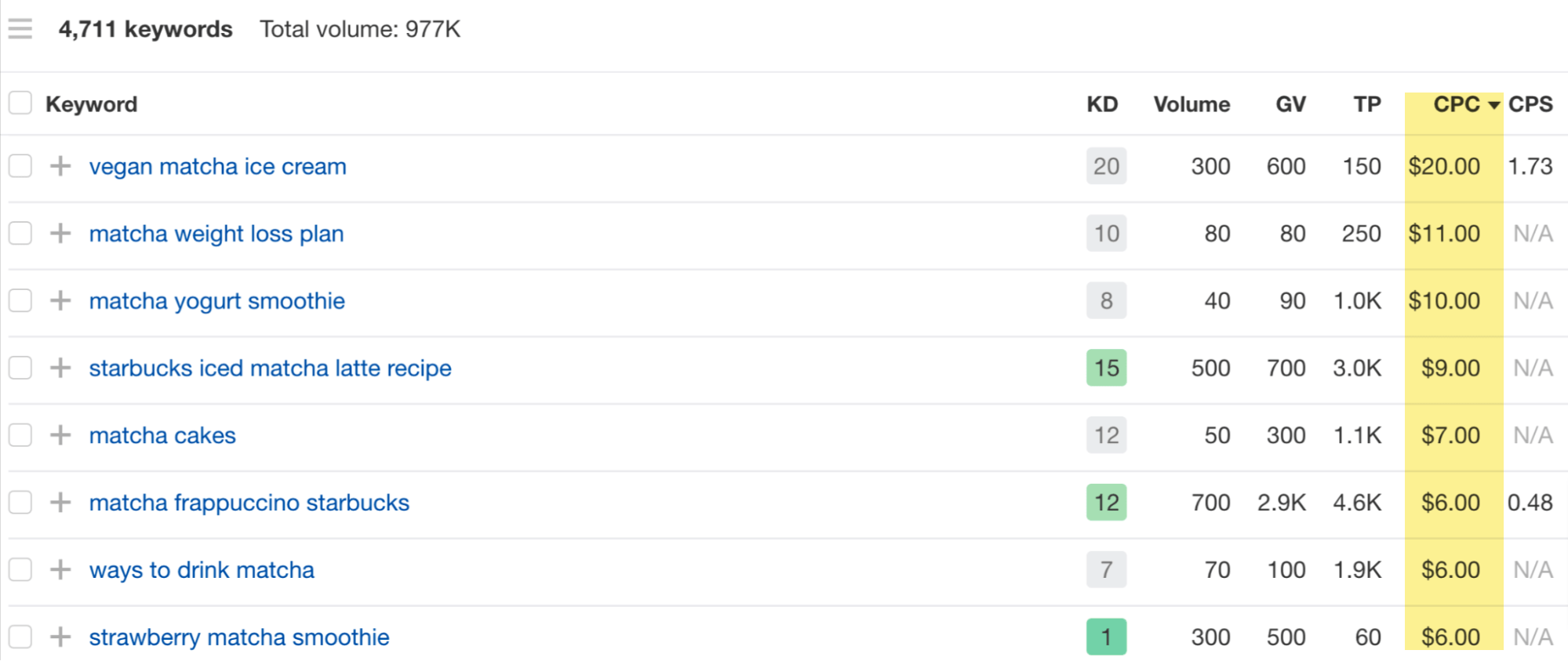
So what to do with difficult keywords? Of course, you may target them any time you wish, but note that they will probably take more time (and backlinks) to rank.
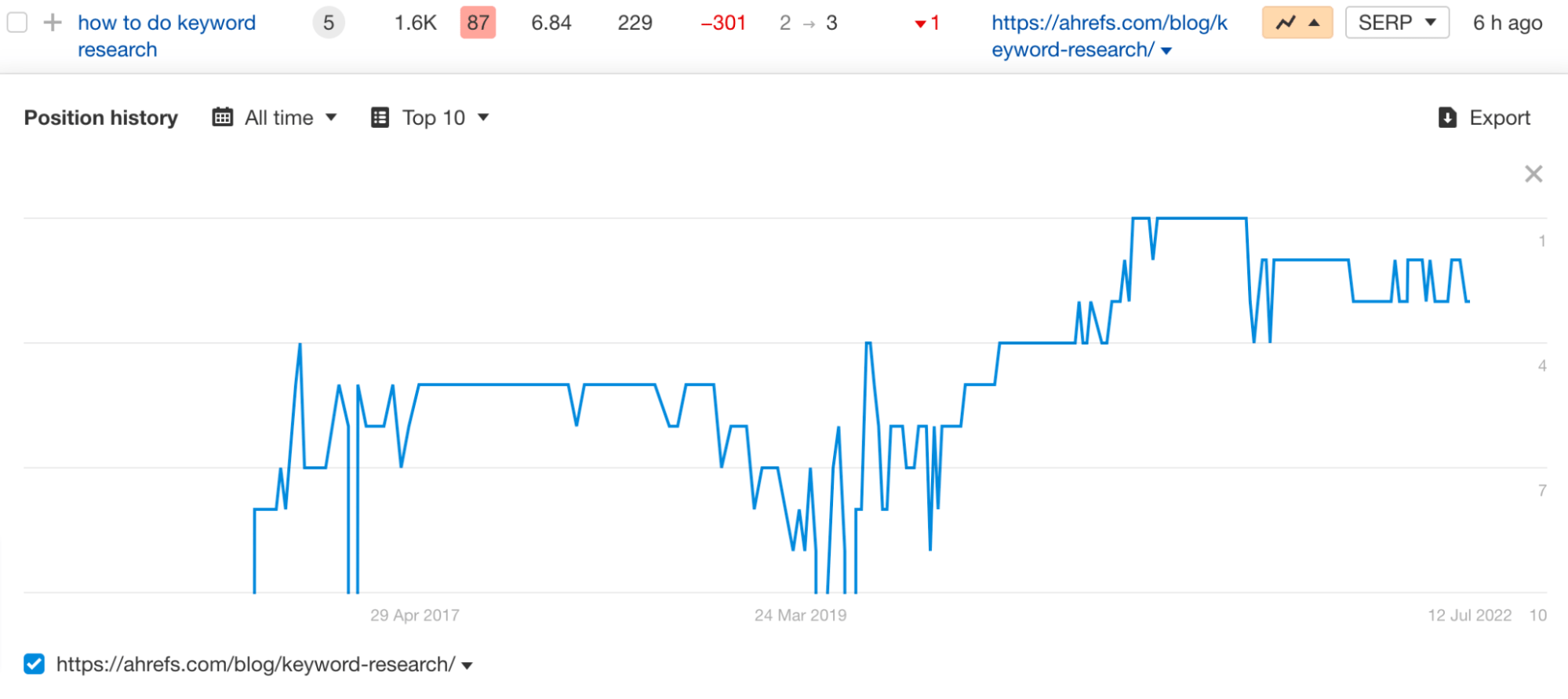
Recommendation
You may also want to try out zero–search volume keywords, as they are usually low-competition too. This article will introduce you to the subject and show you the steps. Do note that this tactic doesn’t always bring results and can be a bit more complicated than what you’ve read above. Also, it may be more suitable for some areas (B2B, emerging technologies) than others.
2. Do SEO for your existing pages
Sometimes, you don’t need to create new content to get more traffic. Your old content may just need some SEO work, including:
- More precise alignment with search intent to better serve the meaning of the search query.
- Refreshing the content, making it more up to date.
- Introducing a unique value to show Google and searchers that you have something new to add to the table (to Google, unique content is quality content).
- Optimizing your title tag to get more clicks from the SERPs (search engine results pages).
- Filling content gaps for more topical relevancy.
- Adding internal links to distribute link equity.
At Ahrefs, we do these things to get more traffic regularly. With multiple successes.
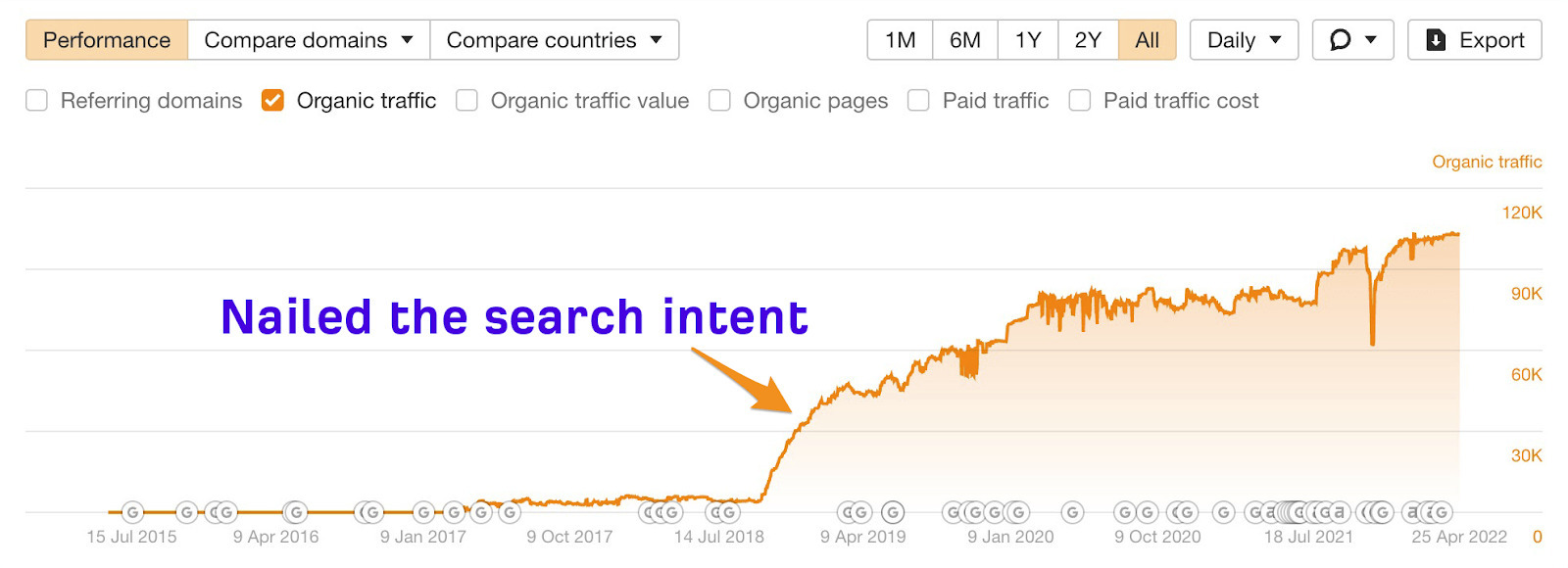
You can follow our step-by-step process with this guide: Republishing Content: How to Update Old Blog Posts for SEO
3. Create a free resource
This tactic is all about creating valuable, unique, high quality content that’s ideally centered around your brand or product—then offering free access to the content.
Whether it’s a printable PDF guide or a tutorial series on YouTube, focus on adding value for your audience. You’ll then start seeing the magic of word of mouth at work.
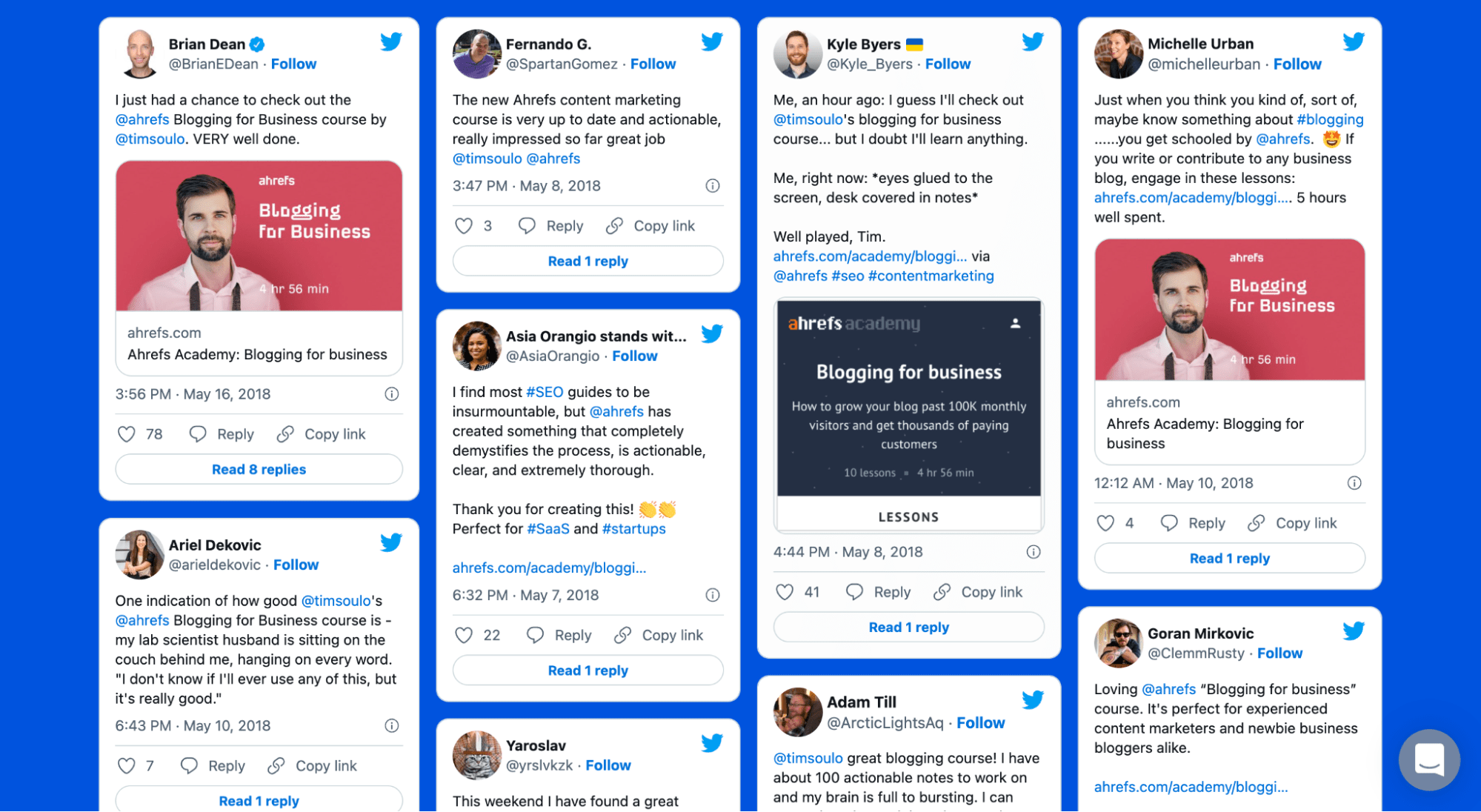
But first, you need a proven topic for your free resource.
You can find inspiration for topics manually by visiting social media profiles of authors and magazines in your niche and looking at the engagement signals: likes, retweets, comments, etc. Additionally, you can browse through online communities and see what resonates with your target audience.
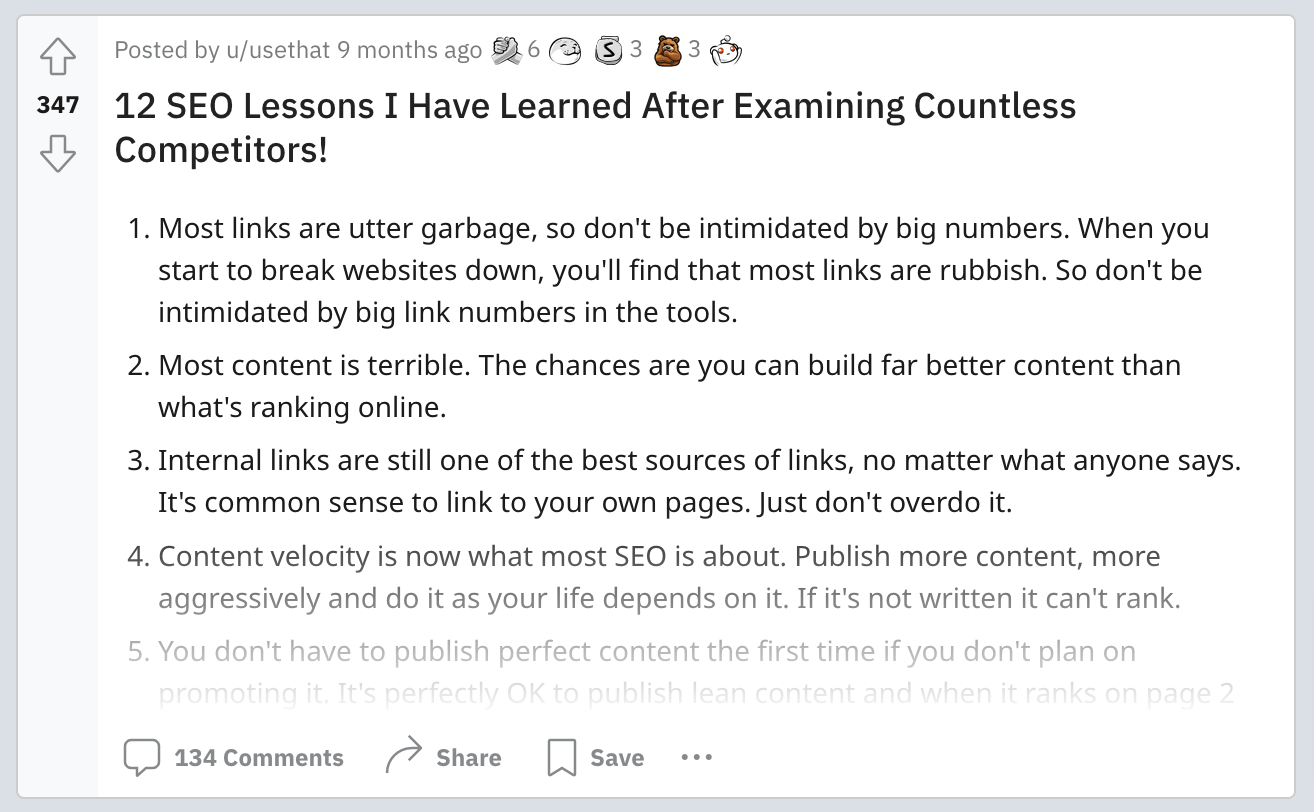
But there are also tools that can help you with this job.
One tool we recommend quite often for any kind of audience research is SparkToro. Just plug in topics your target audience frequently talks about to discover related topics and hashtags (among many other things).

And with an all-in-one SEO toolset like Ahrefs, you can broaden your options with keyword research.

And on top of that, you can reverse engineer what worked for your competitors.
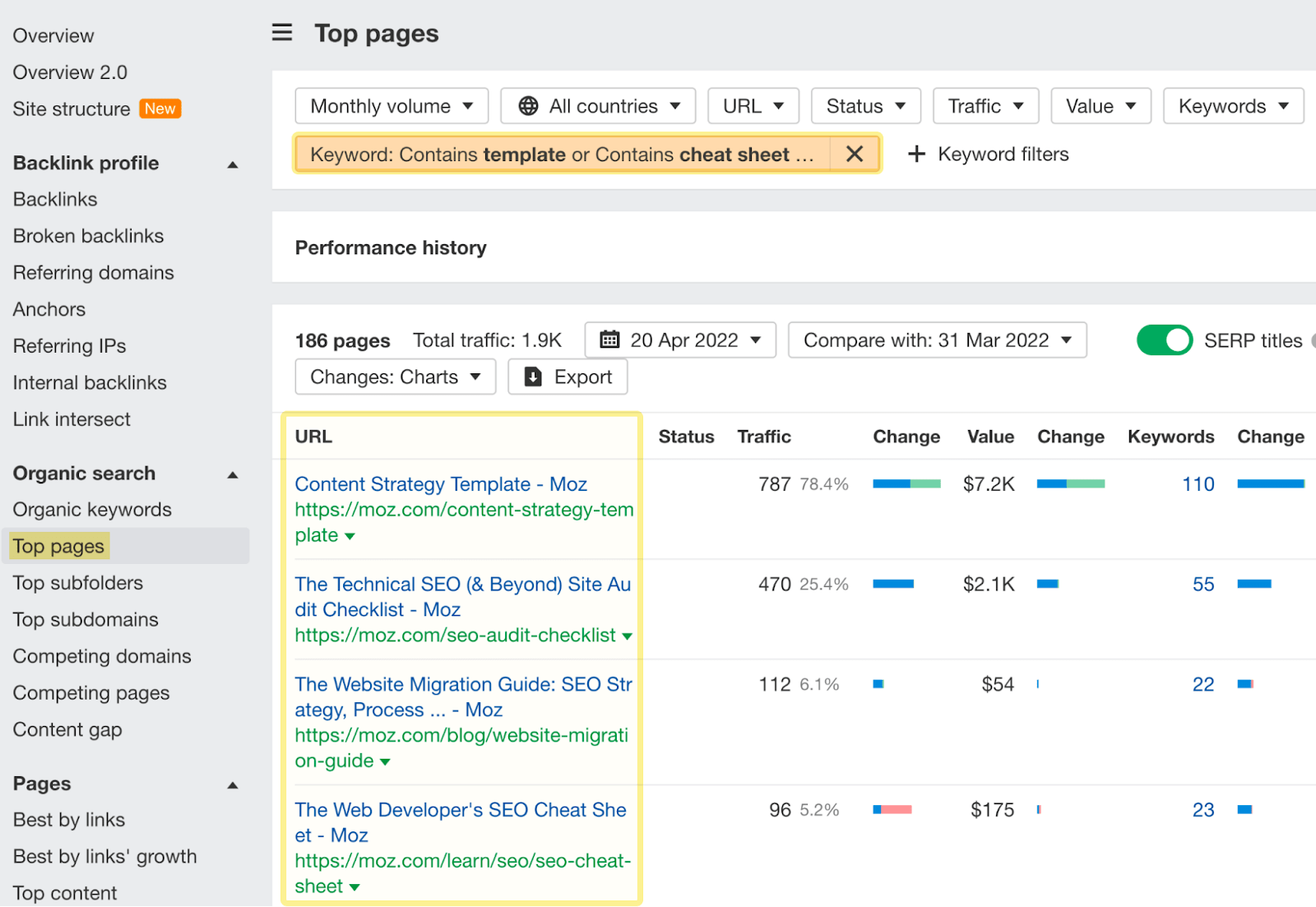
Recommendation
Consider creating content tailored to platforms with native distribution mechanisms. For example, you can create a course on a site like Udemy on how to, say, paint Warhammer miniatures and mention that you own a website on the topic with more cool resources.
4. Partner up for a joint course or webinar
Look for other businesses that target a similar audience but do not compete with you directly.
Then see if they are up for a content collaboration with you. This way, you can pitch to their audience, and they get to pitch to yours.
Here’s an example: In 2018, we worked with Buffer, a social media scheduling tool, to create a webinar titled “How to Get Website Traffic With Evergreen Content and Social Media Marketing.”

While the audience was comprised of digital marketers, our products are different enough and do not compete with each other.
5. Repurpose your content for other marketing channels
Repurposing content is about using existing content and “repacking” it for other marketing channels.
For example, you can chop a larger article into smaller pieces and use them to promote the original piece via guest blogging. Actually, it’s such a common technique that it has its own name: the “Splintering Technique.”

Or you can turn an article into a video and take advantage of YouTube’s search engine and content recommendation algorithms.

Or you can take an entire post, strip it down to a tl;dr version, and publish it on Reddit.

There are other ways to take advantage of this tactic. Check out our complete guide to content repurposing, where we share nine ideas for that.
6. Find guest blogging opportunities
How can you promote your website while writing for others?
When you publish content for other websites, a number of things happen:
- You get a boost to your website traffic (although it’s not the best method for consistent traffic).
- You expose your brand to a new audience.
- The earned link contributes to your backlink profile.
- You can make new connections in the industry.
Apart from preparing a pitch that stands out from the crowd, the key is to find the right places to publish.
For this, you can use Google with search operators. Then you need to vet each page manually. Try our free website authority checker for that last part.
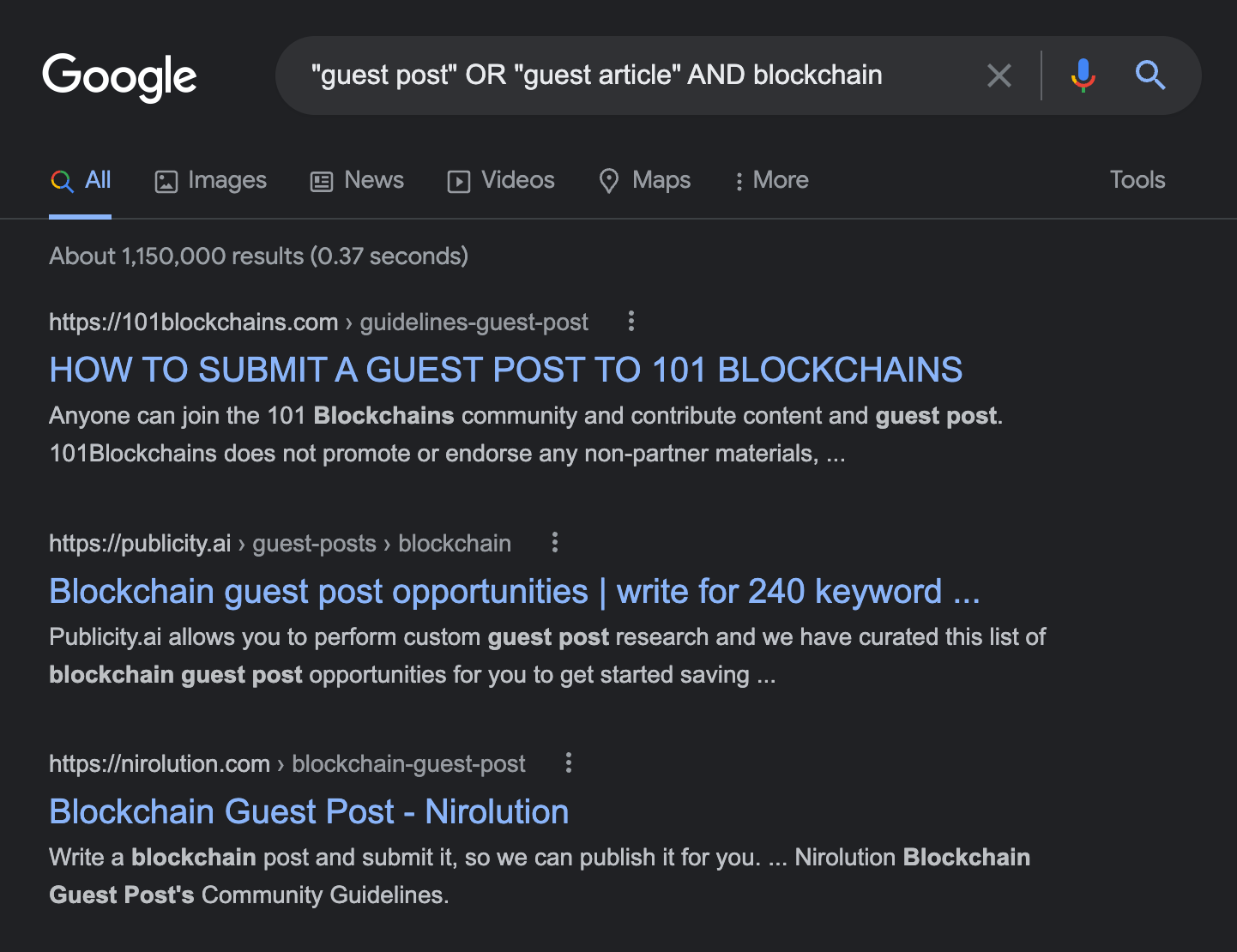
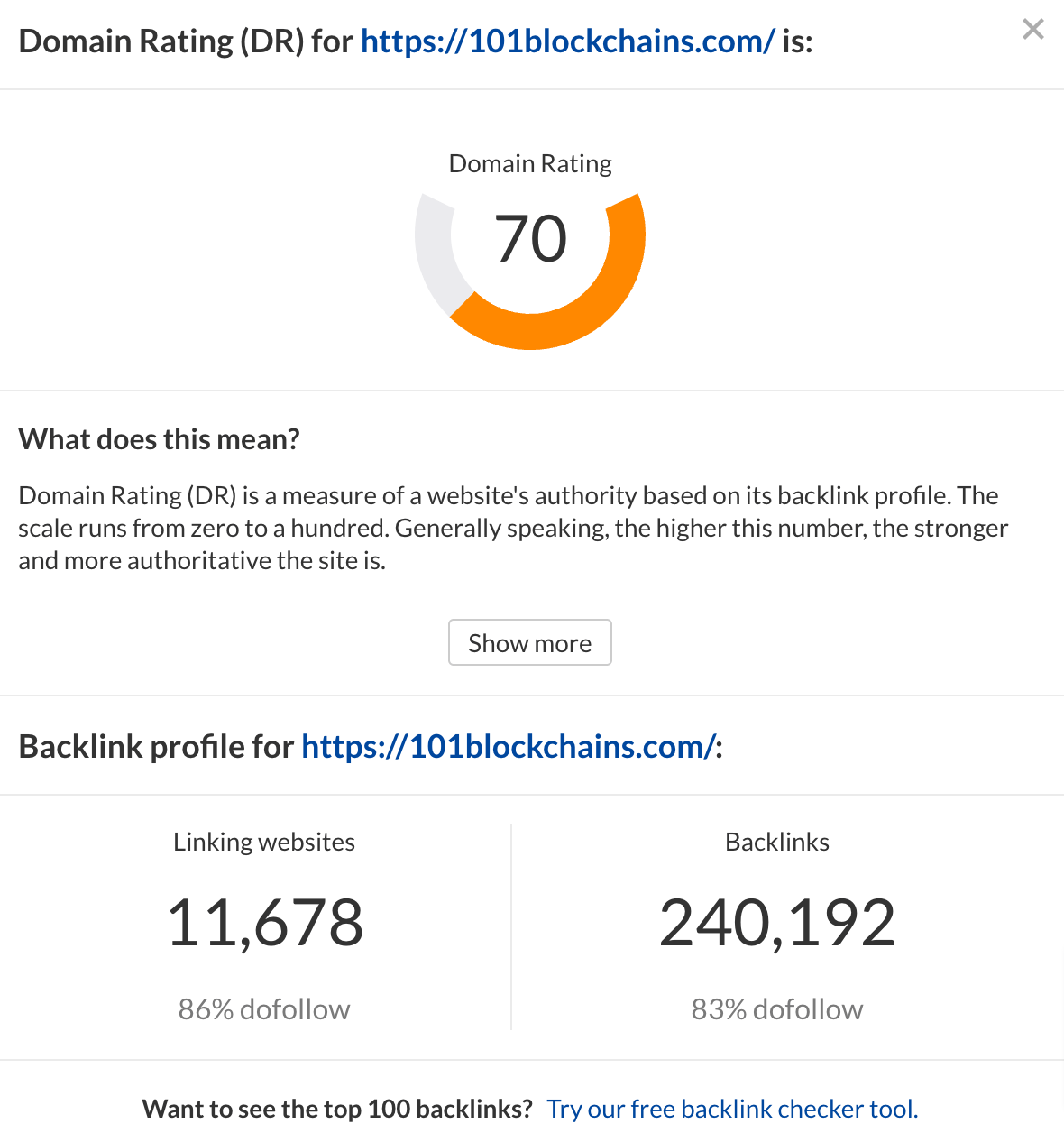
With an Ahrefs sub and our SEO Toolbar, you can also vet the websites right inside the SERPs.

Or use our Content Explorer to get additional insight to filter for results that meet specific performance criteria.

Further reading
- Guest Blogging for SEO: How to Build High-Quality Links at Scale
- I Just Deleted Your Outreach Email Without Reading. And NO, I Don’t Feel Sorry.
7. Syndicate your content
Content syndication is a similar tactic to guest blogging. The only difference is that with content syndication, you publish the same thing in multiple places.
Getting started with content syndication is practically the same as guest blogging. You need:
- Great content.
- Potential syndicates (websites that can publish your content). You can use the same process and tools as described above. The only thing that changes is your search query. So you can use something like “originally appeared on” + [topic] .
- A good pitch to get your foot through the door.
With syndication comes the option to self-syndicate. So unlike guest blogging, you can self-populate your articles to other platforms like Medium, Reddit, or LinkedIn. These platforms have a large audience and their own distribution mechanism, so you can get in front of people’s eyes for free.
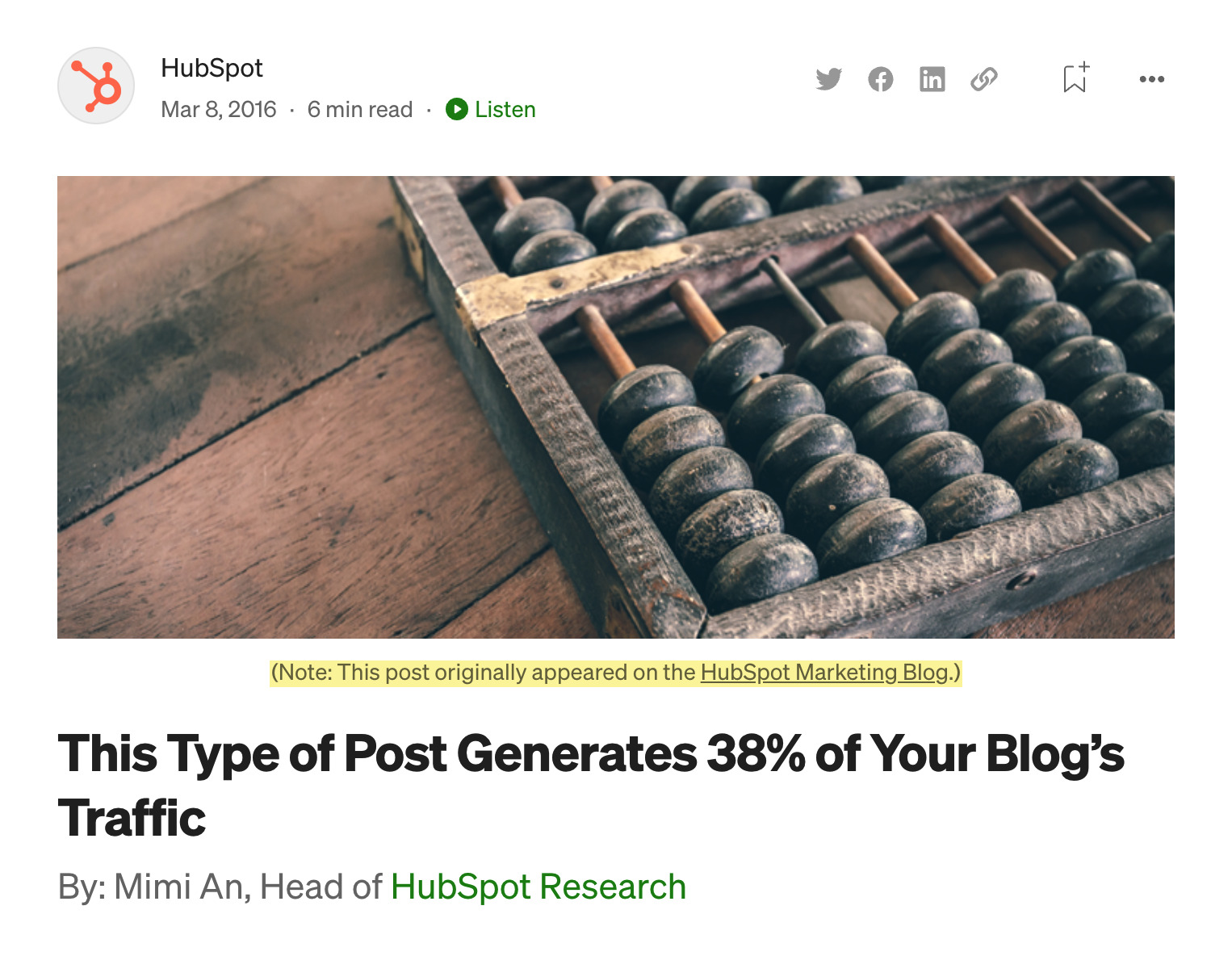
Recommendation
Use a backlink checking tool to see where authors of your choice syndicate their content. In Ahrefs, go to Backlinks report, set the word or phrase filter to “Anchor with surrounding text,” and type “originally appeared on” inside the input field.
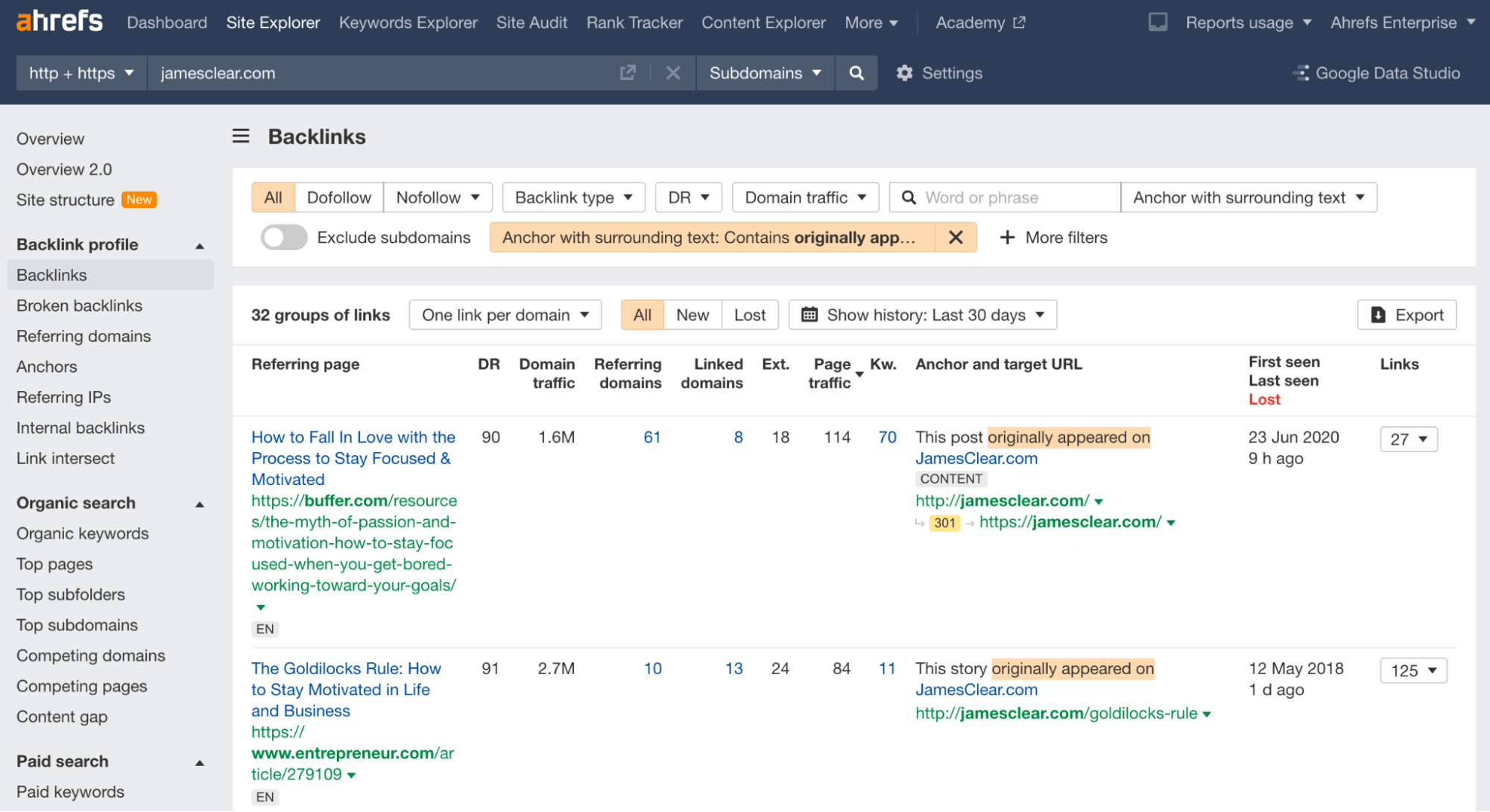
8. Engage with your audience on social media
Social media platforms, including online communities, are places where you can likely find your target audience. You just need to figure out where exactly and how you can provide unique value to them. If you have something important to say, there will be plenty of opportunities to link to your website.

Start by learning more about your audience. Again, for this, I’ll recommend SparkToro.
Another way to find places that mention topics related to your website (or even your website) is to use a web monitoring tool like Google Alerts or our very own Ahrefs Alerts.

Once you’ve zeroed in on your communities, you may want to approach them with these universal tips in mind:
- Pay attention to what works for each audience – After joining, read the rules and dedicate some time to researching the group. Look at how the existing members interact. Also, comment on others’ posts while adding value and being helpful.
- Post thoughtful, insightful comments – Others will begin to return the favor. Don’t be a spammer.
- Start referencing your own website after a while – Only do so after you’ve spent a good amount of time giving back to the community and making some friends. Even then, try to go about it in a way that doesn’t scream “blatant advertisement.” Asking for opinions or positioning your website as something that may help people out are some ways to go about it.
Recommendation
- If there’s no natural way to include a link, don’t do it. Otherwise, your content may be seen as a spam policy violation.
- Social media platforms seem to prefer native continent, i.e., content that is to be “consumed” on the spot instead of accessed via a link. This means sometimes you will have to trade links for engagement.
Case in point. Have you heard about Miss Excel? Her software training business can generate up to six figures per day. Not per month, per day. Even Google Docs tried to correct me on that.

Miss Excel gets customers through social media. But you can rarely come across a direct link to her course in any of her posts. Instead, she directly shares Excel tips on TikTok and Instagram. Here’s a great interview on how she does what she does.

Further reading
- Quora Marketing: ~1 Million Views Generated. Here’s How to Replicate Our Success
- Who Will Amplify This? And Why? – SparkToro
9. Start a community of your own
And how about creating your own community?

- People genuinely like to share thoughts on topics related to your website.
- You can offer a unique value that will attract and retain your audience.
Going further, we can see there are multiple benefits of having a community tied to your website. In terms of promotional aspects, the biggest benefit will likely be word of mouth.
Word of mouth is one of the most effective marketing channels. It will start working organically when community members feel like the value inside the community will benefit others. But you can potentially influence word of mouth by giving people a reason to talk, such as a new study you just published.
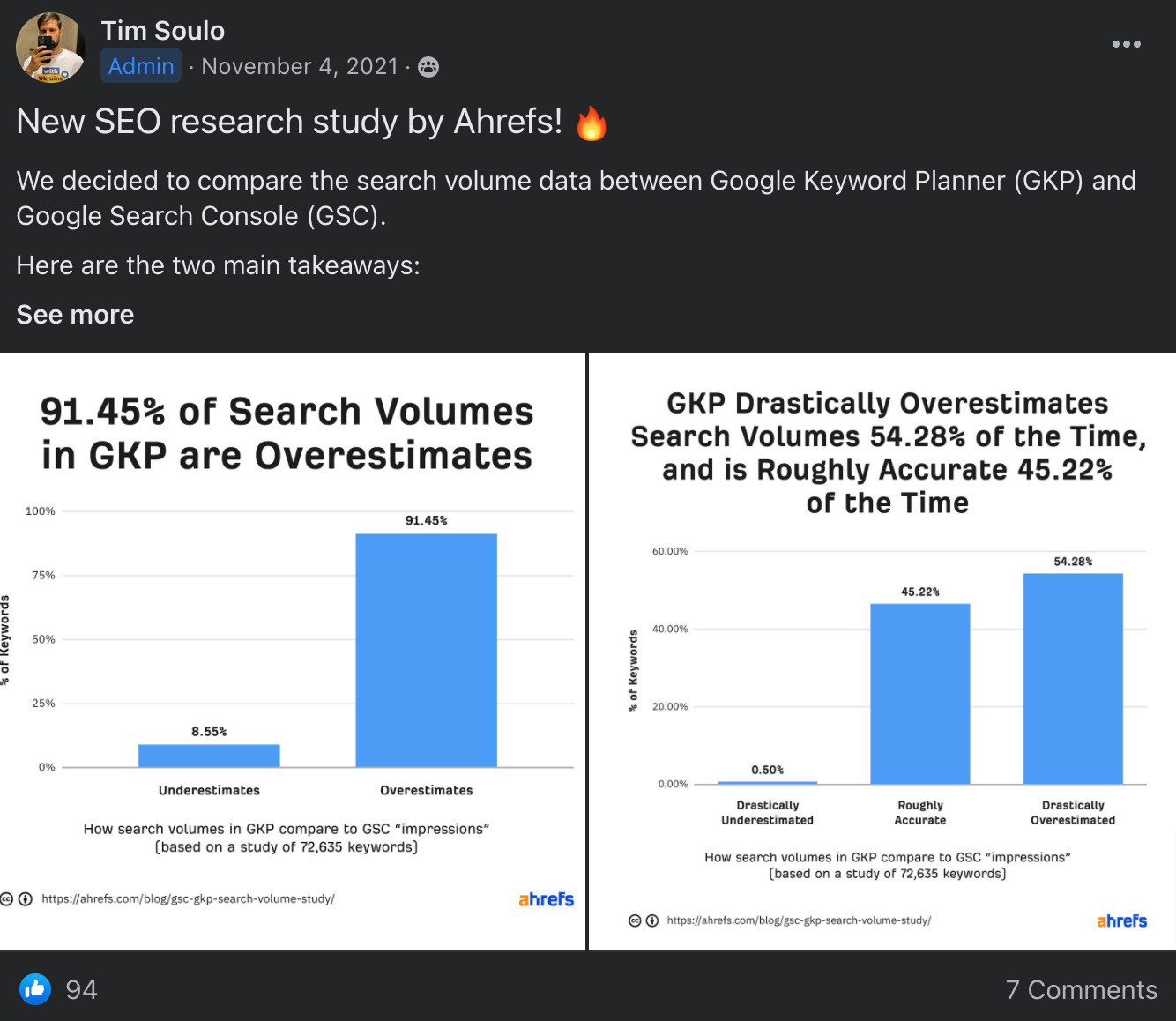
This way, a community can naturally start to attract members and, as a result, promote your website. Just keep in mind that you shouldn’t expect overnight success with this tactic. Treat it, rather, as a long-term investment with dividends paid as you go.
10. Build an email list to keep in touch with your audience
Promoting a website is not only about bringing traffic to it once . You need to have a strategy in place to keep in touch with your audience and encourage them to come back. Email marketing is a great way to do this.
With billions of email users worldwide , email provides unparalleled reach to connect with your audience. What’s more, by segmenting your email list, you can deliver personalized, relevant content that resonates with specific groups, increasing the chances they will engage with your website.
An email marketing list will easily become one of your most valuable assets. Case in point, Hubspot paid around $27MM to acquire a newsletter called the Hustle.

Email marketing is a very cost-effective channel. It has significantly lower overhead costs than traditional advertising, making it a budget-friendly way to drive website traffic. Some studies show that the ROI of email marketing can be as high as 3600%.
It’s one of the easiest channels to track, too. Every email tool out there allows you to track key metrics like open and click-through rates, which also allows you to optimize your campaigns. Quick tip: if you’re using Google Analytics, make sure to turn on integration in your email marketing tool to automatically track traffic from each campaign (no need to manually add UTM tags then).

Speaking of email tools, choosing the one that best fits your budget is fundamental, as costs will rise based on your usage.
There are basically two types of pricing models: based on the number of contacts (e.g., Mailchimp) and based on a number of sent emails (e.g., Brevo). If you’re just starting out with this channel, you may want to choose a tool that will allow you to get as many contacts as possible without breaking the bank.
Of course, building an email list is not that easy. But if email marketing is done in tandem with high quality content marketing, a setup like that puts the process of list-building almost on autopilot. All you need to do is to put up a sign-up form next to your content.
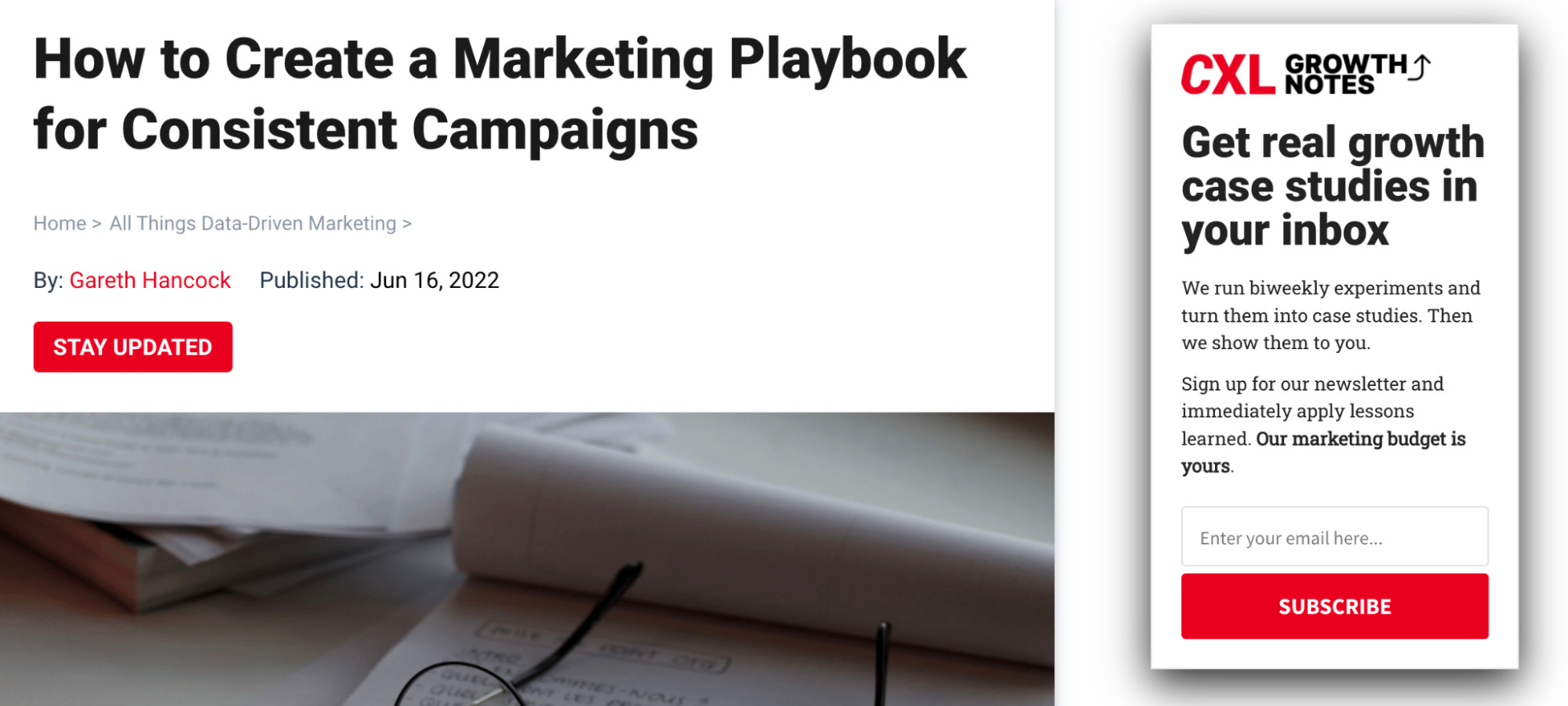
Let’s wrap this section with some tried and tested tips:
- Craft a unique newsletter . Differentiate your newsletter with a distinct design, voice, and exclusive content. Incorporating interactive elements or insider insights can make your emails stand out and deepen subscriber engagement.
- Commit to publishing quality content regularly . After all, the content should attract people to your email list. If you feel like you can use a step back to revisit your blogging strategy, check out this list of blogging tips.
- Experiment with the form of your newsletter . For example, we recently found that Ahrefs’ audience prefers to get a short digest of each article we feature in the email instead of, say, bare links to articles.
- Blend promotional and informational content . Mix sales messages with informative or entertaining content. For example, a fitness brand could pair product promotions with workout tips, fostering a richer, more engaging subscriber experience.
- Segment your audience . Tailor your emails based on subscriber data like interests and past behaviors. Customized campaigns lead to higher engagement by addressing specific needs and preferences.
- Conduct A/B testing . Test variations in subject lines, offers, and calls to action to see what resonates best with your audience. This data-driven approach refines your strategy and improves overall performance.
- Delete inactive email addresses from your list . Removing inactive contacts from your email list enhances deliverability and engagement metrics by ensuring messages reach interested subscribers, and helps reduce costs and comply with data protection laws. It also mitigates the risk of sending to spam traps, preserving your sender reputation.
11. Get listed in local directories (for local businesses)
If you’re a local business owner, getting listed in local directories is a must.
This is because people look for local services on the web all of the time. For this, they use either local service directories or simply plug in a keyword like “lawyer near me” in Google. In the latter case, Google will usually point them to a local directory.
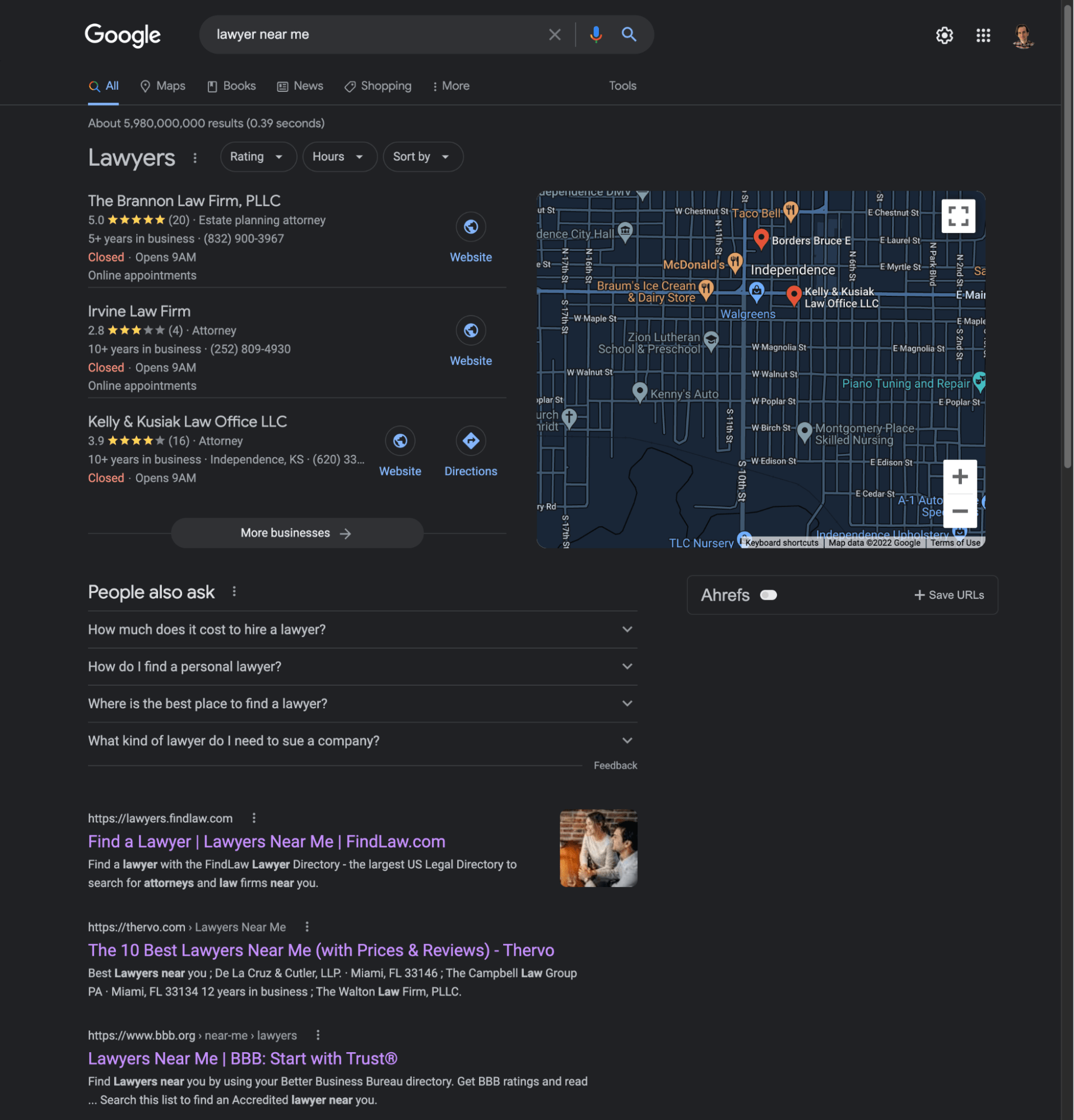
Creating or claiming your Google Business Profile is a good starting point. Setting up the profile is quite straightforward (and free). However, what I recommend here is going a step further and making sure your profile is optimized. Here’s how to do it in 30 minutes.
Completing this step will make your business profile (hence, your website) eligible to show up in Google Map Pack (the search result with a map, as seen in the picture above), Google Maps, and a local knowledge panel when someone looks for your brand.
Next, add your business to relevant local directories. For example, a lawyer may want to list their service for free with Thervo.com. Just make sure to keep all information consistent across platforms.
Once you’re done with adding your business to directories, check out our guide on local SEO to take things a notch higher. Among other things, this guide will show you tactics that can improve your position in the local map pack and how to create content for keywords with local search intent.
12. Do outreach for link building
Outreach done for link building purposes is a tactic where you get your content in front of bloggers and influencers in your industry. The aim is to get them to talk about you and link to you.
This tactic is mainly utilized to boost the “authority” of your pages in the eyes of Google so that these pages rank higher and bring more search traffic.

In its simplest form, outreach is the act of reaching out and asking for a link back to your website. And yet, great outreach at scale is a lot more than just asking for a backlink. The process involves:
- Creating quality content.
- Finding prospects.
- Segmenting your prospects.
- Finding the right contact details.
- Crafting your pitch.
- Scaling your outreach.
Sounds easy, right? But there are actually a lot of details involved that can make or break the process. Also, steps like finding prospects or finding the correct emails are too tedious or even impossible without the right tools.
The best way to go about your outreach process is to pick up a tried and tested process you can simply follow to a T. Here’s one from us, completely free:

Promoting your website through digital PR includes:
- Using services likeHAROorSourceBottleto monitor journalist requests – Sign up and wait for expert commentary requests related to your website or important to your audience. Try also following #journorequest on Twitter.
- Newsjacking – This is about monitoring news to react with expert commentary and thought leadership pieces.
- Pitching linkable assets to journalists and bloggers – You can use something you’ve already created or create something special for that occasion.
All of the above tactics allow you to benefit in three ways:

- Build awareness of your website
- Send traffic to your website when people want to learn more about you
- Boost SEO if the commentary includes a live link to your website
Here are two free tools from Ahrefs that can help you with your digital PR efforts.
The first one is our aforementioned free website authority checker. Thanks to it, you will be able to quickly see the authority of the website.
The second one is our Ahrefs Webmaster Tools. You can use it as a free way to monitor backlinks from your PR efforts.
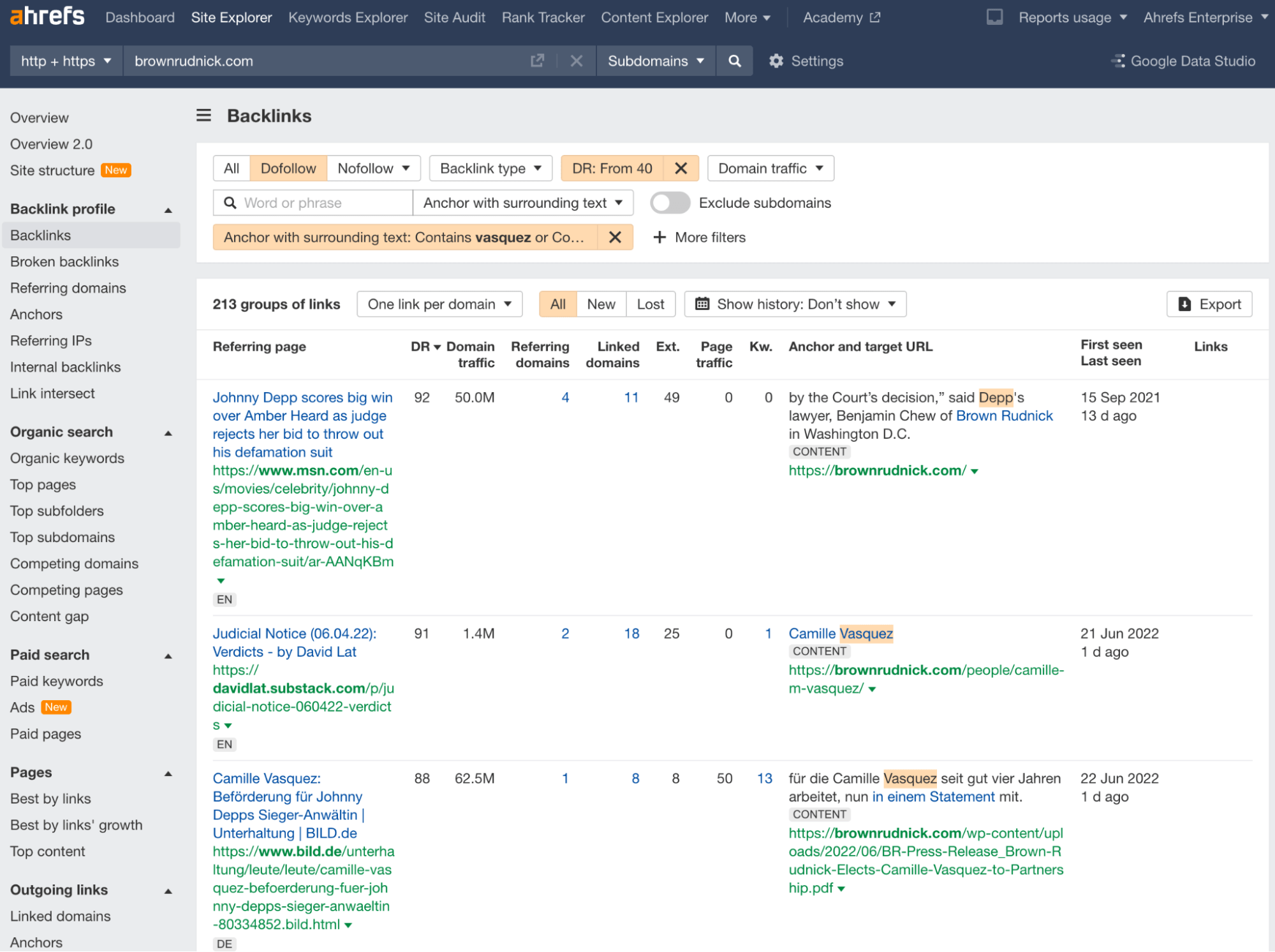
Further reading
- 9 Great Public Relations Tactics With Campaign Examples
- How to Build Backlinks and Get Press Using HARO [Case Study]
- How to Write a Press Release (+ Free Template)
14. Get featured in newsletters and podcasts
Chances are that there is a newsletter in your niche that regularly curates content found on the web.
And chances are, if your content is good enough, it can be featured in one of those newsletters.
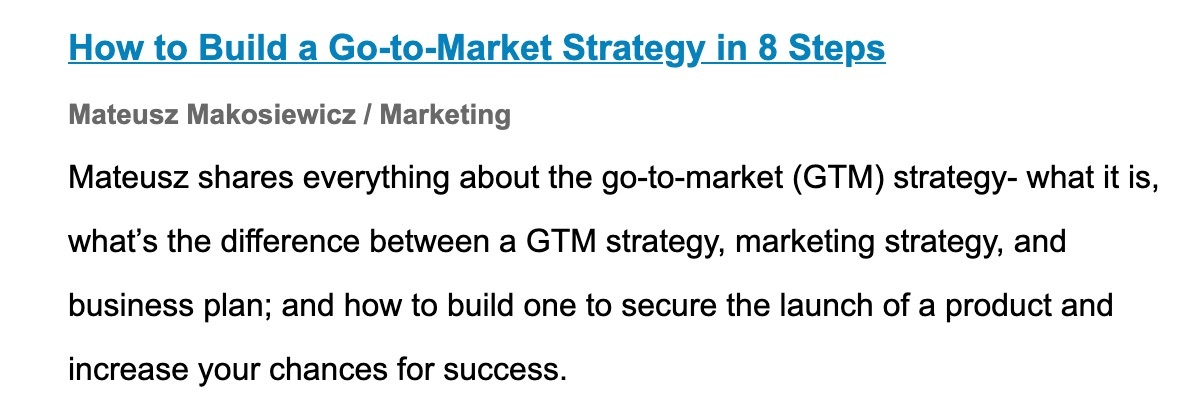
Naturally, a link inside a newsletter won’t count for SEO. But it can lead to links from authors reading that newsletter. And in any case, you’re putting your name on the map and making the newsletter’s subscribers aware of you.
What you need to do here is to find relevant newsletters and show your work in a well-thought-out outreach pitch:

Two words of advice:
- Pitch only your best articles – Remember, you’re pitching to a flesh-and-blood human, and they don’t like spamming.
- Don’t worry if your content doesn’t get chosen this time – Try to reforge that into a relationship with the editor. There will be other chances.
15. Get featured in rankings and reviews
The web is full of rankings and reviews. Chances are that some of them are related to what you do. Getting featured (and linked) is a free way to get some direct referral traffic, boost your SEO, and increase your brand awareness.
If you’re just starting out, you may want to build some authority before you send your first pitch. Keep in mind that editors will screen your website by a number of different criteria—from website design, social media following, to even personally testing your products, recipes, strategies, and whatever you offer. Also, they may be actual experts on the topic.
So what may help you here is segmenting your outreach prospects based on the authority of the website you’re targeting. What you’ll do then is to start from smaller websites and move your way up.
The backlink profile of a website can be a useful, quick proxy for this, so you can use Ahrefs’ Site Audit or the free website authority checker if you don’t own a subscription.
At all times, check your targets manually. This will help you personalize your pitch and potentially discover additional opportunities, such as a special section for “rising stars.”

Another tip here is to focus on webpages that rank very specific types of websites. They can be easier to reach out to since more niche topics tend to have smaller audiences. So for example, if you’re running a blog that focuses on low FODMAP cooking, look for that kind of opportunity instead of “best food blogs.”
16. Leverage influencer marketing to increase reach and convert
Influencer marketing for website promotion involves teaming up with popular online personalities to drive traffic to your site. It’s like when Nike partnered with Michael Jordan to skyrocket their sales, but in this case, the goal is to boost website visits.
It’s reported by marketers to be a very effective strategy – 85% of Influencer’s Marketing Hub respondents believe influencer marketing to be an effective form of marketing. And it worked for Ahrefs, too.
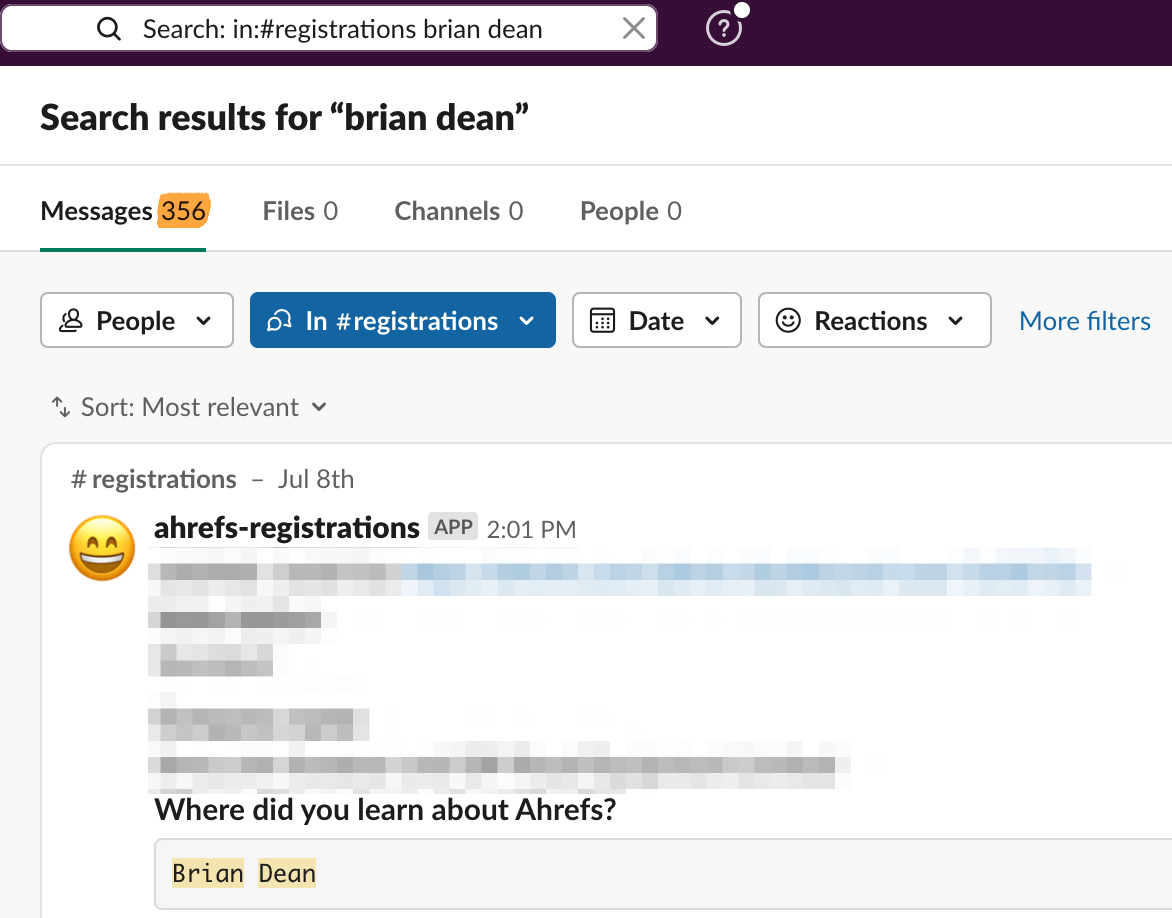
There are many types of influencers, from celebrities with millions of fans to nano-influencers with a few thousand engaged followers.
The key is to find the right match for your website’s target audience, and aim for vanity metrics like follower count. In fact, even major brands collaborate with micro-influencers. For example, Peugeot, the European automobile maker, brought micro-influencers to the Brussels Motor Show to document and promote their experience with the brand, as highlighted in this case study .

Collaboration ideas include having influencers mention your website in their posts, co-creating content that lives on your site, or running contests that direct their followers to your website. Remember to always agree on the partnership details beforehand and give influencers the freedom to maintain their authenticity.
Successful collaborations might lead to turning an influencer into a long-term advocate or brand ambassador for your website, continuously driving their audience to your site.
To kick off an influencer marketing campaign for your website, follow these four steps.
1. Identify your target audience
Suppose you run a website focused on eco-friendly home products. Your target visitors might be environmentally conscious individuals, aged 25 – 45, who are interested in sustainable living. They likely engage with quality content related to eco-friendly practices, recycling tips, and green products on social media platforms like Instagram and Pinterest.
2. Define what you want to achieve (more visits, sign-ups, etc.)
For the eco-friendly home products website, the primary goal could be to increase overall site traffic by 30% within three months. Secondary goals might include boosting the newsletter subscription base by 15% and generating a 20% rise in inquiries about featured products.
4. Look for influencers accepting non-cash compensation
While cash payments are the most common form of influencer compensation, non-cash payments in the form of gifts, free products, and experiences are still widely used, especially for smaller or newer influencers.
Consider performance-based compensation, too – it doesn’t require any cash upfront, and you basically pay with the money earned by the influencer. This form of marketing is often called affiliate marketing .
You can use search through social media platforms to find relevant influencers, but using tools like Sparktoro or Modash will give you better results in a shorter time.
5. Track your campaign’s success
The tool you’ll use will depend on your goals. For example, you can use Google Analytics to track website traffic conversions, and sales can be measured by a special discount code given to the influencer. Tools like Modash also offer built-in performance analytics so you can keep your entire influencer marketing under “one roof”.
Further reading
- Influencer Marketing: Definition, Examples, and Tactics
- Find Influencers: 6 Easy Steps to Choose the Right Ones
Final thoughts
These aren’t the only possible ways to promote your website for free. I do encourage you to experiment and double down on what works. If you think something may work for your audience (and even if it hasn’t been tried before), go for it. But make sure to measure the results.
Keep in mind that your marketing tactics don’t need to be truly unique to be effective. One of the best places to find promotion ideas will always be your competition and other successful businesses—even if they operate in a different industry.
Got questions? Ping me on Twitter.

